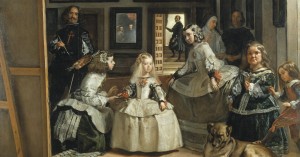In his“Triumph of Art” Part 4 of the TV series Civilizations Simon Schama described Velásquez’ Las Meninas as “a triumph of illusionistic painting”, also, as “a huge brain teaser”. Velasquez himself is “the most cerebral painter of his generation”. Schama asked what is painted on this large canvas we see the back of? possibly the princess or perhaps the king and queen ? “Generation after generation of writers commentators and artists have tried to explain it” but, Schama thinks that “no one has quite got to the bottom of it”. He does not exaggerate the degree to which scholars have found mystery where as a practicing sculptor I have often found a simple, practical explanation for scholars’ mysteries. Of course, it is Las Meninas painted on the front of the huge canvas, self portraits often include the back of the canvas (Las Meninas is approx 3m high). I cannot disagree with his final explanation – the painting is about who is in charge of the way we see but alas my answer is unfortunately the theoreticians, not the painter as Schama implies!

Las Meninas Velasquez
My own inquiry started from the question how did Velasquez actually see what he was painting – obviously he needed a mirror to paint a self-portrait. He could not have seen those standing beside and in front of him without seeing them in the same mirror in which he saw himself; so it must be worth asking the question did he actually use a mirror. It would have had to have been a big one, plate-glass did not exist in 1656 when this picture was painted but there was a hall of mirrors in the royal palace in Toledo which Velasquez was in process of transferring to the new Palace in Madrid at the time he painted Las Meninas. Spain had been receiving tribute from Holland and the mirror we see painted reflecting the king and queen in Las Meninas is in a Dutch frame. The same mirror or an identical one can still be seen in the sacristy of the cathedral in Toledo. We would need two rows of four such mirrors mounted together to cover the figures within the subject matter in the painting. But for a Royal Hall of Mirrors that does not seem an exaggerated possibility. Unfortunately there’s no record of the size of mirrors in the hall but the painting seems to represent the room next door (with minor modifications). When we ask the question did Velasquez actually use a mirror? the answer comes back from the painting itself -YES, eight times. 1. Velasquez changed himself to a righthander, 2. he painted the Infanta in the same year with her parting on the other side of her head. 3 the lighting of the group on the left depends on reflected light from the mirror. Are these not proof enough that he used the mirror I published these ideas in The Artist Magazine in March 1980 but scholars continue to pursue mysteries in painting, clearly miracles are preferred by them to practical explanations.
My straightforward explanation would be useful to artist today who undertake group portraits. It is a technique which I suspect was used by Velasquez’ assistant for his family portrait and by Goya for his royal group, both artists included a self-portrait. But they disguised their method,. Velasquez did nothing to disguise his method. Art scholars think very differently to artists, they prefer written, cerebral evidence to visual clues; and as they have come to dominate the discussion of art in the media and everywhere else, so useful ideas for artists get lost. There seems to be only a one-way traffic between the theoreticians and the practitioners of art. I have offered similar practical explanations for a number of art miracles many of them are on YouTube (see www.nigelkonstam.com). The use of mirrors by Brunelleschi to invent scientific perspective, by Velasquez as above, by Rembrandt to multiply his subject matter and by Vermeer to augment his use of the camera obscura which I believe he used solely to observe unfocused light. Two mirrors crucially helped him to observe light and allowed him to work in a modest sized studio (3m deep). For artists and those who prefer practical explanations to miracles, I strongly recommend my answers to art historical questions.
I can also explain why I believe half the Elgin Marbles are Roman copies. Furthermore, to our surprise the Roman reproductions have been generally preferred to the Greek originals. (see my Elgin Arguments, Also on Youtube
). The extraordinary speed with which the Greeks freed themselves from the previous Egyptian formula which had endured 3000 years can be explained by their use of wax casts from life as the basis of their miraculous transformation in both bronze and stone (see The Bronzes of Riace for bronze and Dionysos for stone). These revelations bring the master works to which they refer down to human scale, examples from which living artists can profit.
I am still looking for a publisher for all this useful information, I have been looking since 1977.